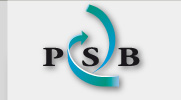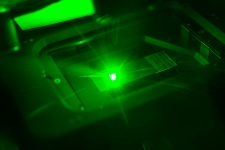


The Cellular Imaging platform grants the access to a confocal microscope (spinning disk S-M4D), a video-microscope (V-M4D), two super-resolution setups (SR-M4D and PALM-M4D) and a flow-cytometer (VYB), all enable to work with living cells.
1 - The confocal system has been updated in May 2022 (S-M4D; Olympus GATACA and Andor). It is based on a motorized IX81 Olympus microscope and equipped with a Nipkow disk (Yogokawa CSU-X1), 6 solid state lasers for real-time confocal imaging of living cells (low laser phototoxicity and opaque thermostatic enclosure) and a photoconversion/ photoactivation module (used, for example, in FRAP experiments). Images can be acquired simultaneously with 2 EMCCD cameras (Andor iXon ultra). The confocal imaging has few advantages over the traditional epifluorescence technique, including an improved resolution, a higher contrast due to drastic reduction of the background and an optical sectioning.
2 - The epifluorescence imaging station (V-M4D, Olympus) is composed of a new inverted Olympus IX83 fully motorized microscope, a 16-channel LED source, and equipped with a thermostatic incubation chamber for live cell imaging. Acquisition of images is achieved with a sCMOS camera (Hamamtsu Orca Flash4; Volocity)
3 - The flow-cytometer (VYB, Miltenyi biotech) is equipped with three lasers (8 fluorescence channels) and covers the emission wavelengths used on optical microscopes. It is automatable (multiwell plates, immuno-staining, dilutions), and compatible with magnetic columns Miltenyi (isolation of rare events).
4 - The SAFe360 microscope from Abbelight and Olympus (SR-M4D). This new microscope was installed on the M4D imaging platform in 2021 and aims to reinforce our super-resolution capabilities (PALM/ STORM/ PAINT and single particle tracking). The microscope allows 2D/3D multicolor imaging of fixed and living cells with a resolution of few tens of nanometers, as well as single particle tracking experiments with a localization precision up to 5-10 nm for bright organic fluorophores. The system is equipped with a laser combiner (405 nm, 488 nm, 532 nm, 561 nm, 640 nm et 730 nm), a module for homogeneous EPI/HiLo/TIRF illumination and two sCMOS Hamamatsu Fusion cameras offering a large field of view and high acquisition speeds (more than 100 frames per second). The microscope is highly automated and controlled via the NEO software. For a more detailed information you can contact us or visit the manufacturer’s website: https://www.abbelight.com/solutions/abbelight-instruments/#SAFe360
5 - The home-built super-resolution setup (PALM-M4D). This is a noncommercial system based on an inverted Olympus IX81 microscope, equipped with 2 EMCCD cameras (Photometrics) and 6 lasers (405 nm, 488 nm, 532 nm, 561 nm, 643 nm and 730 nm) controlled by an acousto-optic filter (AOTF). The Micro-Manager v2.0 software is used to control the microscope with cameras and to perform the acquisitions of images, whereas the Labview code allows a precise lasers control. This microscope is recommended for more experienced users and can be modified/adapted on demand for a particular need or a scientific project. More details on the IBS web site.
Three workstations with the software for microscopy and cytometry data analysis are available in a dedicated room (568).
Image analysis: Volocity and Imaris;
Super-resolution data analysis: NEO and open source solutions (e.g. FiJi);
Cytometric analysis: MacsQuant and Flowlogic.
– Location: room 547 in the IBS building
– Access mode: Authorized users can access freely the equipment of the platform (microscope and post-treatment dedicated computer), after they have validated the internal training session, and accepted the conditions of use.
For more complex projects or if a specific expertise is requested (collaboration), we can provide a technical assistance for some or all of the experiments planned (observation and post-treatment).
– Cost: Users are charged for the operation costs calculated per hour . Contact the staff in charge of the platform for further information.